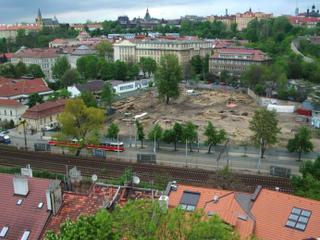Prague Trip Report, Part 11: Traveler info
Information for travelers

Photo: Tramcars passing archeology/ construction site to north of Vysehrad.
People get around downtown Prague on electric tram cars and on the Metro, which has three lines. A no-transfer ticket costs the local equivalent of about 40 cents; 60 cents with transfer; multi-day passes are also available.
About twenty dollars will get you to or from the airport in a "Čedaz" van (buy tickets in the airport terminal) or if you get a reputable taxi. (Not all taxis in Prague are reputable but odds are good if you get one called by your hotel; we relied on a taxi company, AAA, recommended and called by Philee & Marianna.) The airport is roughly the size of Albuquerque's and not hard to navigate; a "C" wing is being constructed which should give it more capacity. Outside the city center, buses take the place of trams.
I did bring my International Driver's Permit but didn't drive and would not likely recommend driving in the city to a first-time visitor; the drivers are a bit wild, the signs are a bit unfamiliar, trams have an absolute right of way, and parking in the central city is frustratingly hard to obtain.
The city core from the Prague Castle through the Old Town and Wenceslas Square (Prasky Hrad od Stare Me'sto a Vaclav Namesti') is thronged with tourists but they are uncommon elsewhere even in other scenic parts of the city. Learning some words of Czech got us lots of appreciation from the people we met and helped us in exploring the less touristy areas.
Western/American style food is readily available in the touristy areas; more authentic Czech food is more available off the beaten path. If you search hard enough, you can also find other ethnic foods such as Japanese, Chinese, etc. We had heavy-duty continental breakfasts with Czech ham, cheese, cereal, toast, and a variety of breads and rolls, some of them quite rich. Small sweet pancakes are also popular for either breakfast or dessert, and there were all sorts of nifty desserts. Steak, pork, and chicken are common; seafood is not since the Czech republic is landlocked though we did see oysters and other maritime delicacies being served from the buffet on a dinner cruise boat as it passed by. Goulash of course is a popular dish; so too are various forms of dumplings.
Sauces are different, often interesting and quite good, such as plum or apricot sauces on meats and a savory Czech-style barbecue sauce we had on a grilled steak.
The local equivalent of a dollar will get you a half liter of good beer in all but the most touristy places. Describing Czech beer and how it's served and related customs would be a whole article/essay/chapter in and of itself. Water and soft drinks can be more expensive than beer. (Beer was a complimentary selection on Czech Airlines, but somehow Carol Anne managed to pass up free beer for once – 8 a.m. seemed like a strange time of day to be drinking beer, though some of our fellow passengers did imbibe. Perhaps if we’d been in Česko longer, the whole notion of beer for breakfast would have seemed quite natural.)
Food prices were generally reasonable, though certainly not parallel to the USA – some things were more expensive than expected and others much cheaper; for example, a bottle of Perrier water for Gerald cost more than my steak at our first dinner; both were about the equivalent of six dollars. (This place was somewhat off the beaten path.)


2 Comments:
One comment on that photo at the top of this entry -- it's not a construction site. It's an archeological dig. But yes, Prague is certainly full of construction and reconstruction; it's a city on the rise.
Archeology didn't seem very important under communism, nor was making the buildings lot nice. So, the Czechs have had a lot of catching up to do since the Velvet Revolution.
Post a Comment
<< Home